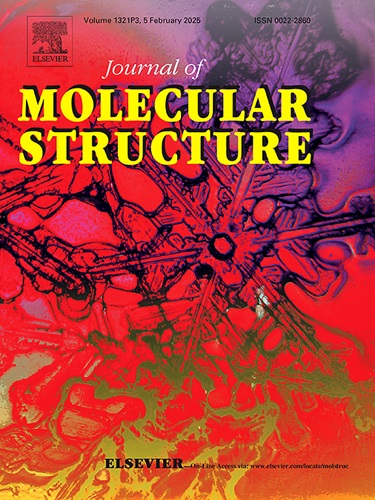黄皮草液体发酵新代谢产物及其除草活性
IF 4
2区 化学
Q2 CHEMISTRY, PHYSICAL
引用次数: 0
摘要
在黄皮菌培养液中发现了两个新的氯化倍半萜,lepistatins d-E(1-2)和一个新的三oreudesmane倍半萜(6),以及六种已知化合物。已知化合物包括两个氯代倍半萜,lepistatins A-B(3-4),一个eudesmane型倍半萜类pterodontriol B(5),两个trinoreudesmane倍半萜类(7-8)和一个diketoperazine diatretool(9)。通过NMR, hrems, UV, IR,圆二色性和单晶x射线晶体学等理化性质分析鉴定了它们的结构。在拟南芥种子萌发抑制试验中,化合物5和9表现出显著的抑制活性,IC50值分别为88.48 μg/mL和75.03 μg/mL。这些新型氯化倍半萜类化合物的发现及其显著的生物活性强调了L. sordida作为新型除草剂来源的潜力。本文章由计算机程序翻译,如有差异,请以英文原文为准。

New metabolites from Lepista sordida through liquid fermentation and their herbicidal activities
Two new chlorinated sesquiterpenes, lepistatins d-E (1–2) and one new trinoreudesmane sesquiterpenoid (6) were discovered in the culture broth of Lepista sordida, along with six known compounds. The known compounds include two chlorinated sesquiterpenes, lepistatins A-B (3–4), one eudesmane-type sesquiterpenoid pterodontriol B (5), two trinoreudesmane sesquiterpenoids (7–8), and one diketopiperazine diatretol (9). Their structures were identified by analyzing their physicochemical properties, including NMR, HREIMS, UV, IR, circular dichroism, and single-crystal X-ray crystallography. Notably, in the germination inhibition test of Arabidopsis thaliana seeds, compounds 5 and 9 exhibited significant inhibitory activity, with IC50 values of 88.48 μg/mL and 75.03 μg/mL, respectively. The discovery of these novel chlorinated sesquiterpenes and the significant bioactivity of the identified compounds underscore the potential of L. sordida as a source of new herbicidal agents.
求助全文
通过发布文献求助,成功后即可免费获取论文全文。
去求助
来源期刊

Journal of Molecular Structure
化学-物理化学
CiteScore
7.10
自引率
15.80%
发文量
2384
审稿时长
45 days
期刊介绍:
The Journal of Molecular Structure is dedicated to the publication of full-length articles and review papers, providing important new structural information on all types of chemical species including:
• Stable and unstable molecules in all types of environments (vapour, molecular beam, liquid, solution, liquid crystal, solid state, matrix-isolated, surface-absorbed etc.)
• Chemical intermediates
• Molecules in excited states
• Biological molecules
• Polymers.
The methods used may include any combination of spectroscopic and non-spectroscopic techniques, for example:
• Infrared spectroscopy (mid, far, near)
• Raman spectroscopy and non-linear Raman methods (CARS, etc.)
• Electronic absorption spectroscopy
• Optical rotatory dispersion and circular dichroism
• Fluorescence and phosphorescence techniques
• Electron spectroscopies (PES, XPS), EXAFS, etc.
• Microwave spectroscopy
• Electron diffraction
• NMR and ESR spectroscopies
• Mössbauer spectroscopy
• X-ray crystallography
• Charge Density Analyses
• Computational Studies (supplementing experimental methods)
We encourage publications combining theoretical and experimental approaches. The structural insights gained by the studies should be correlated with the properties, activity and/ or reactivity of the molecule under investigation and the relevance of this molecule and its implications should be discussed.
 求助内容:
求助内容: 应助结果提醒方式:
应助结果提醒方式:


